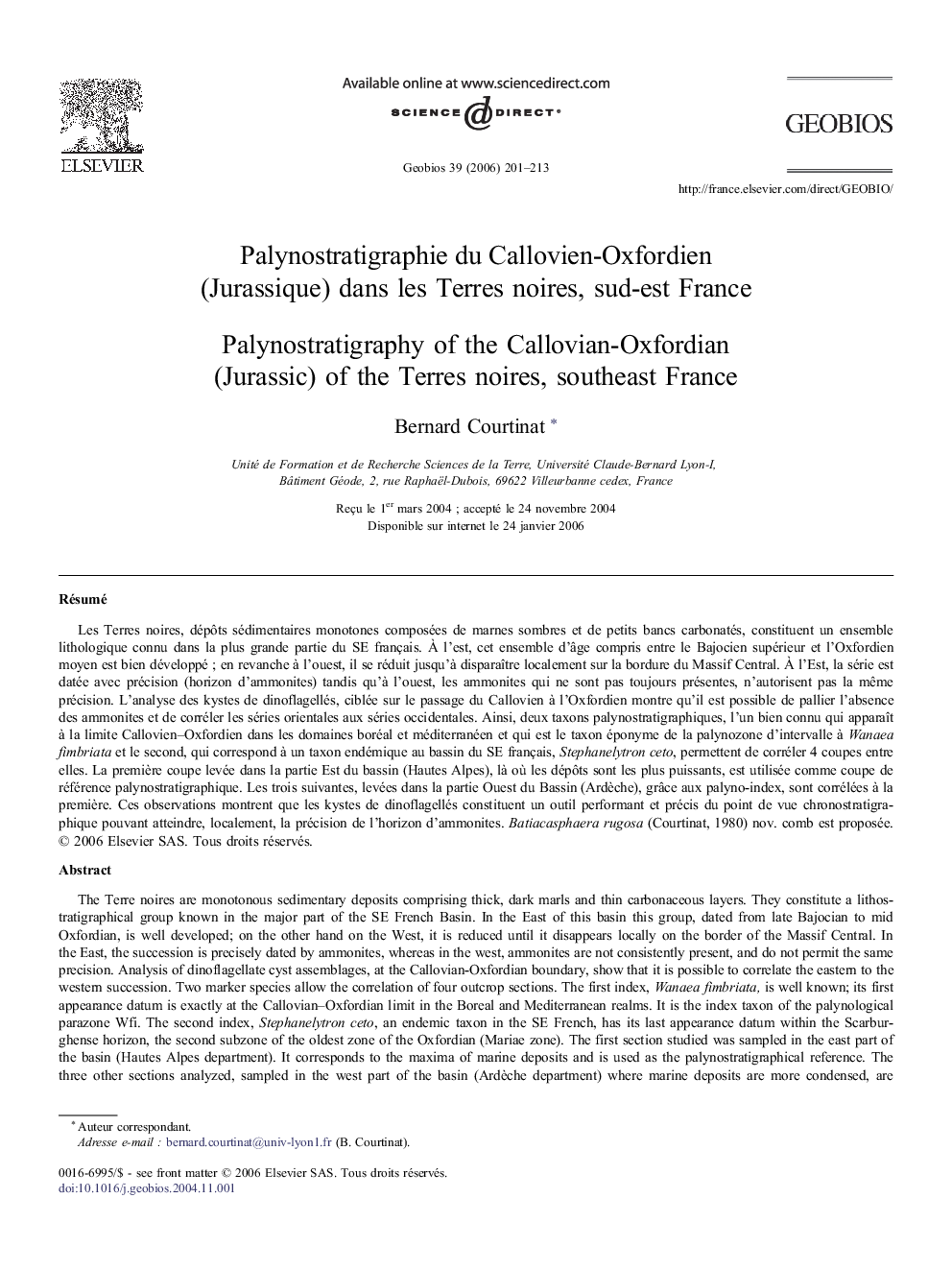| کد مقاله | کد نشریه | سال انتشار | مقاله انگلیسی | نسخه تمام متن |
|---|---|---|---|---|
| 4748650 | 1360131 | 2006 | 13 صفحه PDF | دانلود رایگان |

RésuméLes Terres noires, dépôts sédimentaires monotones composées de marnes sombres et de petits bancs carbonatés, constituent un ensemble lithologique connu dans la plus grande partie du SE français. À l'est, cet ensemble d'âge compris entre le Bajocien supérieur et l'Oxfordien moyen est bien développé ; en revanche à l'ouest, il se réduit jusqu'à disparaître localement sur la bordure du Massif Central. À l'Est, la série est datée avec précision (horizon d'ammonites) tandis qu'à l'ouest, les ammonites qui ne sont pas toujours présentes, n'autorisent pas la même précision. L'analyse des kystes de dinoflagellés, ciblée sur le passage du Callovien à l'Oxfordien montre qu'il est possible de pallier l'absence des ammonites et de corréler les séries orientales aux séries occidentales. Ainsi, deux taxons palynostratigraphiques, l'un bien connu qui apparaît à la limite Callovien–Oxfordien dans les domaines boréal et méditerranéen et qui est le taxon éponyme de la palynozone d'intervalle à Wanaea fimbriata et le second, qui correspond à un taxon endémique au bassin du SE français, Stephanelytron ceto, permettent de corréler 4 coupes entre elles. La première coupe levée dans la partie Est du bassin (Hautes Alpes), là où les dépôts sont les plus puissants, est utilisée comme coupe de référence palynostratigraphique. Les trois suivantes, levées dans la partie Ouest du Bassin (Ardèche), grâce aux palyno-index, sont corrélées à la première. Ces observations montrent que les kystes de dinoflagellés constituent un outil performant et précis du point de vue chronostratigraphique pouvant atteindre, localement, la précision de l'horizon d'ammonites. Batiacasphaera rugosa (Courtinat, 1980) nov. comb est proposée.
The Terre noires are monotonous sedimentary deposits comprising thick, dark marls and thin carbonaceous layers. They constitute a lithostratigraphical group known in the major part of the SE French Basin. In the East of this basin this group, dated from late Bajocian to mid Oxfordian, is well developed; on the other hand on the West, it is reduced until it disappears locally on the border of the Massif Central. In the East, the succession is precisely dated by ammonites, whereas in the west, ammonites are not consistently present, and do not permit the same precision. Analysis of dinoflagellate cyst assemblages, at the Callovian-Oxfordian boundary, show that it is possible to correlate the eastern to the western succession. Two marker species allow the correlation of four outcrop sections. The first index, Wanaea fimbriata, is well known; its first appearance datum is exactly at the Callovian–Oxfordian limit in the Boreal and Mediterranean realms. It is the index taxon of the palynological parazone Wfi. The second index, Stephanelytron ceto, an endemic taxon in the SE French, has its last appearance datum within the Scarburghense horizon, the second subzone of the oldest zone of the Oxfordian (Mariae zone). The first section studied was sampled in the east part of the basin (Hautes Alpes department). It corresponds to the maxima of marine deposits and is used as the palynostratigraphical reference. The three other sections analyzed, sampled in the west part of the basin (Ardèche department) where marine deposits are more condensed, are correlated and dated due to dinoflagellate cyst markers observed in the reference section. These results indicate that dinoflagellate cysts are a reliable correlation tool. Batiacasphaera rugosa (Courtinat, 1980) nov. comb is proposed.
Journal: Geobios - Volume 39, Issue 2, March–April 2006, Pages 201–213